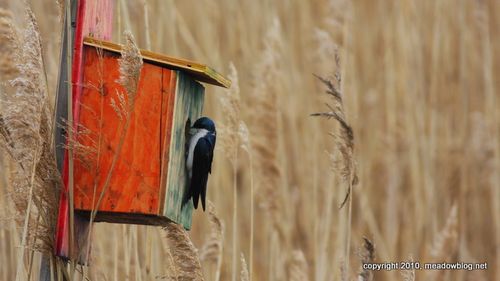We wrote this article on Tree Swallows for a recent edition of The South Bergenite, and thought we would share it here.
Waterfront housing in the Meadowlands has been going up at an amazing rate this spring, and occupancy rates are approaching 100 percent.
Welcome to the New Jersey Meadowlands Commission’s Tree Swallow Nesting Box Program, an annual community effort that provides housing for 175 tree swallow couples and their youngest offspring.
“It’s simply amazing to see how readily these little birds adapt to nest in the boxes,” says NJMC Naturalist Gabrielle Bennett-Meany, who has been involved with the program since 1998. “There is an instant satisfaction to putting up a nest box and seeing, within moments, a pair of tree swallows appear. It’s an incredible sight.”
Last week, Bennett-Meany and fellow NJMC Naturalist Michael Newhouse erected the boxes at Harrier Meadow in North Arlington and DeKorte Park in Lyndhurst. They will also be putting up the boxes in the Mill Creek Marsh in Secaucus.
The tree swallows have certainly benefited, but so human beings.
“These birds zip around the marshes and feed on mosquitoes and other insects, which makes them extremely beneficial as a biological insect control,” says Bennett-Meany. “And they are absolutely beautiful. The males have a metallic blue back with a hint of green and a pure white belly, while the females are a bit duller.”
The program began nearly two decades ago, when NJMC Don Smith and a few others put up the small wooden nesting boxes in the marsh. He saw immediately that the tree swallows loved the boxes, and suggested that more be built. A local Boy Scout troop built 24 boxes the following year, and the program has kept expanding ever since, with all sorts of community groups and local companies providing the boxes.
The tree swallows have taken to the nesting boxes for one simple reason: They need a place to live. The birds have suffered a severe housing shortage over the years because of habitat lost to development and the clearing of forests.
“By building nest boxes and putting them in the marsh, we have a pretty good impact on helping the population,” says Bennett-Meany.
Setting the boxes on wooden stakes and sticking them in the water along the edges of marshes is a key part of the program. By locating the nests over water, raccoons and other predators can’t reach them, and other birds – particularly house sparrows – are far less likely to claim the nest boxes for themselves.

